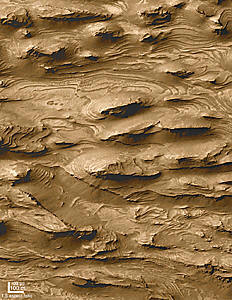
 |
|
|
|
|
|
Mudstones on Mars? |
|
 Our
interest in Mars is inspired by the basic principle that weathering
of Martian basalts in the presence of water should give rise to
clays and mudstones. The differential weathering seen in MOC images
suggests alternating hard and soft layers of rock and, by analogy
with Earth, suggests that the softer intervals are mudstone
dominated. Our
interest in Mars is inspired by the basic principle that weathering
of Martian basalts in the presence of water should give rise to
clays and mudstones. The differential weathering seen in MOC images
suggests alternating hard and soft layers of rock and, by analogy
with Earth, suggests that the softer intervals are mudstone
dominated.Schieber, J., 2001. Finding life on Mars: A mudrock geologist's perspective. 32nd Lunar and Planetary Sciences Conference, Houston, March 12-16th 2001, Abstract Volume - CD. download PDF file (left click on link and click on "Save as"...) |
|
|
|
|
 Mars Science Laboratory (MSL) is
being designed to assess whether Mars ever had an environment
capable of supporting microbial life. Determining past habitability
on Mars will give the scientific community a better understanding of
whether life could have existed on the red planet and, if it could
have existed, an idea of where to look for it in the future. Mars Science Laboratory (MSL) is
being designed to assess whether Mars ever had an environment
capable of supporting microbial life. Determining past habitability
on Mars will give the scientific community a better understanding of
whether life could have existed on the red planet and, if it could
have existed, an idea of where to look for it in the future.
|
|
| The West Candor region of Mars
(part of Valles Marineris) contains numerous outcrops of layered
rocks that may be of sedimentary origin. In order to determine
whether these layers were indeed sediments, graduate student Kevin
Thaisen is working on a project to unravel the depsotional
architecture of these rocks. Systematic differences in the
depositional architecture of volcaniclastic vs aqueous deposited
sedimentary rocks may shed light on the proportions of true
sedimentary rocks vs volcaniclastics and impact surge deposits. At right: MOC image MOC2-658 from West Candor Chasma (image NASA/JPL/MSSS). Four low angle truncation surfaces (disconformities) are marked with yellow arrows and circled numbers. The surface marked (2) shows deeper incision and what appears to be channel-fill complexes (red arrows). Blue arrows point to exhumed channels. White arrow and question mark point to features that may be exhumed impact craters. |
 |
|
|
|
| Back to SHALE RESEARCH LAB Main Page | |
| Back to IU Department of Geological Sciences | |
|
© Jürgen Schieber, IU Bloomington Department of
Geosciences Last updated: February 08, 2022. |
|